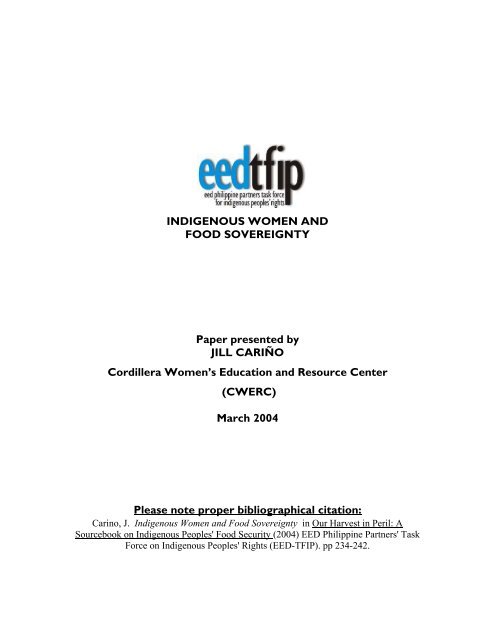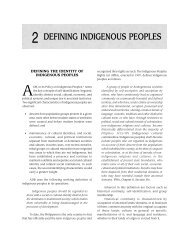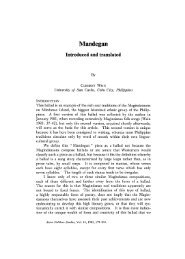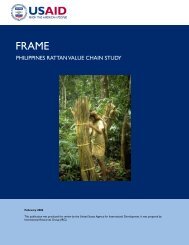Indigenous Women and Food Sovereignty - Philippine Culture
Indigenous Women and Food Sovereignty - Philippine Culture
Indigenous Women and Food Sovereignty - Philippine Culture
Create successful ePaper yourself
Turn your PDF publications into a flip-book with our unique Google optimized e-Paper software.
INDIGENOUS WOMEN AND<br />
FOOD SOVEREIGNTY<br />
Paper presented by<br />
JILL CARIÑO<br />
Cordillera <strong>Women</strong>’s Education <strong>and</strong> Resource Center<br />
(CWERC)<br />
March 2004<br />
Please note proper bibliographical citation:<br />
Carino, J. <strong>Indigenous</strong> <strong>Women</strong> <strong>and</strong> <strong>Food</strong> <strong>Sovereignty</strong> in Our Harvest in Peril: A<br />
Sourcebook on <strong>Indigenous</strong> Peoples' <strong>Food</strong> Security (2004) EED <strong>Philippine</strong> Partners' Task<br />
Force on <strong>Indigenous</strong> Peoples' Rights (EED-TFIP). pp 234-242.
Introduction<br />
<strong>Indigenous</strong> <strong>Women</strong> <strong>and</strong> <strong>Food</strong> <strong>Sovereignty</strong><br />
Jill Cariño, Cordillera <strong>Women</strong>’s Education <strong>and</strong> Resource Center<br />
The availability of food for the indigenous peoples of the <strong>Philippine</strong>s largely<br />
depends on their access to <strong>and</strong> control over their l<strong>and</strong>s <strong>and</strong> resources <strong>and</strong> on the<br />
continued practice of their traditional livelihoods. All these are threatened, <strong>and</strong> hunger<br />
is now a daily problem for many poor people. <strong>Indigenous</strong> peoples’ l<strong>and</strong>, resources <strong>and</strong><br />
biodiversity are continuously under attack by outside forces, causing the loss of<br />
traditional sources of food. The present state of biodiversity of food sources in many<br />
communities can no longer secure the food needs of local folk.<br />
Every October 16, World <strong>Food</strong> Day, people all over the world would celebrate the<br />
abundance of food. True, abundance, not scarcity, best describes the world’s food<br />
supply: Enough wheat, rice <strong>and</strong> other grains are produced to provide every human being<br />
with 3,500 calories a day, not even counting other foods like vegetables, beans, nuts,<br />
root crops, fruits, meats <strong>and</strong> fish. Enough food is available to provide 4.3 pounds of<br />
food per person a day worldwide: 2 ½ pounds of grain, beans <strong>and</strong> nuts, about a pound<br />
of fruits <strong>and</strong> vegetables, <strong>and</strong> nearly another pound of meat, milk <strong>and</strong> eggs (<strong>Food</strong> First,<br />
Institute for <strong>Food</strong> <strong>and</strong> Development Policy, 1998).<br />
But amidst this abundance, hunger prevails:<br />
• Every year, hunger kills 112 million people worldwide (<strong>Food</strong> First).<br />
• A total of 792 million people in developing countries remain chronically hungry.<br />
• Around three-quarters live in rural areas, many come from countries where there<br />
is conflict <strong>and</strong> more than 60% are women.<br />
• There are more chronically hungry people in Asia, but 18 of 23 countries facing<br />
the most severe problems are African (PANOS, <strong>Food</strong> for All, 2001).<br />
• As of 1994, 122,942 families or about 51% of Cordillera families live below the<br />
poverty threshold. This means they do not have sufficient income to meet their<br />
food <strong>and</strong> other basic requirements (NEDA 1999).<br />
• All the Cordillera provinces are among the 20 poorest provinces in the country,<br />
more popularly called “Club 20”. The region ranked 5 th among the 15 regions in<br />
the country with the highest incidence of poor families (NEDA 2000).<br />
The problem is not that there is not enough food to go around. The problem is<br />
that most people are too poor to buy the food they need, while others, like the<br />
indigenous peoples, have lost their traditional sources of food (<strong>Food</strong>less Day statement,<br />
CWERC-Innabuyog).
<strong>Food</strong> Security <strong>and</strong> <strong>Sovereignty</strong> for the People<br />
For the basic masses, food security is simply “being able to eat three meals a<br />
day, with food readily available from local resources that can sustain the family’s daily<br />
dietary needs” (Peasant women of Dalupirip, Itogon, 2003).<br />
But food security is not enough. What we need is food sovereignty, meaning, the<br />
right to food, including the right to the l<strong>and</strong> <strong>and</strong> resources that produce the food we<br />
need.<br />
For the Cordillera people, the region’s rich natural resources -- l<strong>and</strong>, natural<br />
biodiversity, coupled with customary systems of environmental protection <strong>and</strong> mutual<br />
cooperation -- have sustained the indigenous peoples since time immemorial.<br />
Traditional farmers’ varieties of rice, legumes, fruits, vegetables, livestock, fish, coffee<br />
<strong>and</strong> other food crops have fed generations of indigenous peoples. To ensure food<br />
security in the whole community, it is customary for all households to help each other<br />
during food shortages. It is also inherent in indigenous communities to protect <strong>and</strong> not<br />
to abuse nature. The women play a special role in production by doing about 90% of the<br />
work in the rice fields, aside from protecting traditional varieties of seeds <strong>and</strong> ensuring<br />
that there is enough food on the family table.<br />
Threats to <strong>Food</strong> <strong>Sovereignty</strong> of <strong>Indigenous</strong> Peoples<br />
The indigenous peoples face serious threats to their food sovereignty <strong>and</strong><br />
survival. Through what is now aptly described as “development aggression,” large-scale<br />
mining <strong>and</strong> dams continue to overrun productive agricultural l<strong>and</strong>. The rivers are<br />
dammed, polluted or silted by mine waste causing the loss of fish <strong>and</strong> other food.<br />
Logging, deforestation <strong>and</strong> government reservations have increasingly ruined<br />
<strong>and</strong> wiped out forests, depriving the people of forest products <strong>and</strong> traditional food.<br />
As stated by Filipino indigenous women during a workshop on January 2004:<br />
“Government laws, programs <strong>and</strong> so-called development projects are being<br />
imposed without our free prior <strong>and</strong> informed consent. These violate our right to<br />
self-determination <strong>and</strong> (they) provide no benefits. (These include) forest laws<br />
such as the NIPAS, IPAS, IFMA, Forestry Code; industries such as mining, logging<br />
<strong>and</strong> agribusiness; hydropower projects such as San Roque Dam, Kaliwa Kanan,<br />
Laiban Dam, Abulug; eco-tourism projects such as the Pacific Coast City/Green<br />
Circle, Clark Development Corporation Pinatubo Project, Mangyan Heritage<br />
National Park; agricultural programs funded through loans <strong>and</strong> Official<br />
Development Aid (ODA) such as CECAP, CHARM, CASCADE, Aurora Integrated<br />
Development Program” (Communiqué, NIWW, 2004).<br />
Commercial agriculture is killing subsistence production <strong>and</strong> making indigenous<br />
people heavily reliant on loans <strong>and</strong> credit, if only to keep their production going. The<br />
influx of imported vegetables, grains <strong>and</strong> fruits has left legions of indigenous folk<br />
cultivating commercial vegetables bankrupt. After using <strong>and</strong> getting exposed to<br />
hazardous agro-chemical products, indigenous farmers have suffered from serious<br />
health problems, including abnormalities of their offspring.<br />
The cash economy has also reduced the role of women from producers to farm<br />
workers. In subsistence production, women peasants are more or less in control of their
production. With the cash economy, the capitalist, trader-supplier <strong>and</strong> usurer control<br />
agribusiness.<br />
The introduction of modern varieties of crops dependent on agro-chemical<br />
inputs has destroyed the soil <strong>and</strong> caused the extinction of traditional varieties of rice,<br />
vegetables <strong>and</strong> other food crops. The heavy use of inorganic, agro-chemical inputs for<br />
high-yielding varieties results in higher production costs, which eat into the meager<br />
earnings of poor farmers. Farm yield is decreasing, pushing people to migrate or<br />
engage in other cash-earning occupations to buy food.<br />
Similarly, traditional practices of cooperation such as the “innabuyog”, “ububbo”<br />
<strong>and</strong> “tinnulungan” are giving way to cash-based relations that weaken community<br />
solidarity.<br />
Military operations in many communities have also prevented poor farmers from<br />
tending their rice fields or swidden farms <strong>and</strong> from hunting or fishing for fear of their<br />
lives.<br />
Lack of money prevents many families from buying commercial food products<br />
that could augment their daily food requirements. This has caused health problems like<br />
rising incidence of malnutrition, goiter, ulcer <strong>and</strong> other food-related illnesses. The use<br />
of pesticides <strong>and</strong> fertilizers <strong>and</strong> the consumption of chemical-laden food products have<br />
also caused many illnesses.<br />
Globalization <strong>and</strong> anti-people policies <strong>and</strong> projects of the government have<br />
worsened the plight of the indigenous people, including women, with particular impacts<br />
on women’s role as food producers.<br />
<strong>Indigenous</strong> <strong>Women</strong>’s Role in Ensuring <strong>Food</strong> <strong>Sovereignty</strong><br />
<strong>Indigenous</strong> women in the <strong>Philippine</strong>s are largely peasants engaged in subsistence<br />
agriculture in mountainous interior communities. <strong>Indigenous</strong> women who live along<br />
coastal areas like the Dumagats in Quezon are engaged in fishing. As subsistence<br />
peasants, indigenous women do the backbreaking <strong>and</strong> tedious agricultural work of<br />
clearing, planting, weeding, harvesting, <strong>and</strong> selecting seeds. Such a role has enabled<br />
them to acquire a vast knowledge in agriculture. They play an important role in seed<br />
selection <strong>and</strong> storage, herbal medicines, various uses of flora, pest management, soil<br />
fertility management, the best season for planting specific species of plants, <strong>and</strong> what<br />
plants suit a particular terrain <strong>and</strong> type of soil. They also tend domestic animals for<br />
food <strong>and</strong> cultural rituals. With the growing needs for cash, these livestock are now<br />
being raised as an additional cash source (Innabuyog-Gabriela, 2004).<br />
<strong>Indigenous</strong> women peasants also play an important role in health-related<br />
concerns or on community medicine. The knowledge they have acquired on herbal<br />
medicines is shared with their communities. Involved more in rearing children, women<br />
are also responsible in transferring indigenous knowledge to children, including<br />
indigenous agricultural knowledge <strong>and</strong> technology, h<strong>and</strong>icraft-making, dances <strong>and</strong><br />
songs.<br />
The cash economy has pushed some indigenous women <strong>and</strong> their communities<br />
to produce commercial vegetables, fruits, rice, corn <strong>and</strong> other cash crops. Even<br />
traditional crafts like loom weaving among Igorot women in the Cordillera, Mangyan<br />
women in Mindoro <strong>and</strong> the Lumad women in Mindanao have turned into a commercial<br />
activity. Bead products have also become a cash source for Mangyan women.
In times of food shortage, the mother is mainly responsible to find ways to feed<br />
her family. It is culturally imposed that the woman shoulders the burden of feeding her<br />
family <strong>and</strong> earning money for other pressing needs. Many are forced to migrate outside<br />
their community to find ways to earn income.<br />
In the Cordillera, the women earn daily wages from “por dia” (per day) odd jobs<br />
within or outside their community. They offer their services in cleaning houses,<br />
washing clothes, tending gardens, helping in domestic chores, or in construction.<br />
Others also join the small-scale miners in Loacan in Itogon town in Benguet Province.<br />
<strong>Women</strong> who are used to doing heavy work like mining are best chosen in construction<br />
work because they are physically able <strong>and</strong> are very thorough in their work.<br />
Por dia jobs pay P80.00 to P150.00 per day, which is just enough to buy a kilo of<br />
rice <strong>and</strong> a kilo or less than a kilo of galunggong, a kind of fish poor Filipinos commonly<br />
choose. But por dia jobs are also seasonal <strong>and</strong> very unstable. So to earn income, some<br />
women raise a couple or three pigs, cultivate commercial flowers, <strong>and</strong> make brooms.<br />
When they cannot find jobs, women are forced to acquire loans either in cash or<br />
kind in order to feed their families. Some women borrow rice <strong>and</strong> some essential items<br />
from grocery stores, which they pay after they get paid for their por dia jobs.<br />
A macho culture still prevails in most of indigenous peoples’ communities. So<br />
while women play an important role in economic production, their political life is<br />
limited <strong>and</strong> sometimes restricted traditionally. However, there are tribes or groups<br />
where women are also leaders or are given chieftain <strong>and</strong> peace-pact holder titles like<br />
certain tribes in the Cordillera <strong>and</strong> in Mindanao. Generally, indigenous women still<br />
assume traditional roles of gathering food <strong>and</strong> tending to the children while political<br />
deliberations within the indigenous socio-political systems are going on.<br />
The particular case of the Ibalois of Benguet<br />
Threats to <strong>Food</strong> Security <strong>and</strong> Agricultural Biodiversity<br />
The natural resources <strong>and</strong> biodiversity in the Ibaloi communities of Itogon are<br />
rapidly deteriorating. Much as the people depend on local resources for their food<br />
security, they regret that these are not as productive as they were about 10 to 15 years<br />
ago.<br />
Ibaloi farming folk now recognize that the fertility of their farm soil has steadily<br />
deteriorated. The accumulated use of HYVs together with the use of inorganic<br />
fertilizers <strong>and</strong> pesticides has turned the soil acidic, leading to low production. As a<br />
result, traditional varieties of rice can no longer survive in farml<strong>and</strong>s used for HYV<br />
production. The introduction of HYV rice <strong>and</strong> inorganic inputs has destroyed, if not<br />
poisoned, the once fertile soil of many communities.<br />
The introduction of HYVs has altered also the spending capacity <strong>and</strong> inflow of<br />
income of the people. The high cost of agricultural inputs requires large expenditures<br />
from farming households. Instead of spending money to buy food, money is allocated
to purchase seeds, pesticides <strong>and</strong> fertilizers. The purchase of these expensive seeds<br />
<strong>and</strong> inputs has decreased the people’s net income.<br />
The mines <strong>and</strong> dams along the Agno River also threaten the food security <strong>and</strong><br />
biodiversity in Itogon after the river was polluted <strong>and</strong> silted, thanks to toxic mine<br />
wastes. The water of the Agno River has now become shallower because of<br />
accumulated silt from the mines. For many years, Benguet Corporation <strong>and</strong> Itogon-<br />
Suyoc mining companies had disposed of their mine tailings into the Antamok <strong>and</strong><br />
Ambalanga rivers <strong>and</strong> other tributaries of the Agno River. Tailings dams built by the<br />
companies, which were supposed to contain mine wastes, had collapsed on several<br />
occasions, finding their way into the rivers. The Baayan Creek used to give Ucab<br />
villagers fish <strong>and</strong> shells. But Benguet Corporation built a tailings dam along the creek<br />
<strong>and</strong> is now polluted.<br />
The construction of hydropower dams along the Agno River had deprived the<br />
people from their traditional sources of livelihood such as gold mining or “panagsayyo”.<br />
After the Binga dam was built upstream of the communities, Ibaloi folk could<br />
no longer extract gold particles from the riverbed. This lessened the additional income<br />
brought into each household, particularly in the villages of Dalupirip <strong>and</strong> Ballococ. The<br />
water quality of the river has also deteriorated after the Binga <strong>and</strong> Ambuklao dams were<br />
built. Not only that. During the typhoon season when the dams’ caretakers have to<br />
release water, residents along the riverbanks cannot sleep for fear of soil erosion <strong>and</strong><br />
flooding. Releasing water from the dams often has caused damage to lives <strong>and</strong><br />
property.<br />
Due to illegal logging <strong>and</strong> deforestation, wild animals in the forest, which used to<br />
help give protein to local folk, have disappeared.<br />
One of the more recent threats to food security is l<strong>and</strong> conversion. What used<br />
to be rice fields <strong>and</strong> vegetable farms are now being converted into green house<br />
production farms for non-food crops such as cut flowers. The need for cash to buy<br />
food, pay for children’s education, utility bills, <strong>and</strong> other basic needs, has prompted<br />
many community folk to engage in floriculture. If the trend continues, all farml<strong>and</strong>s<br />
devoted to food production would become a sea of flowers. But this would further<br />
aggravate the rice shortage already being experienced by the people.<br />
Threatening communities like Loacan <strong>and</strong> Ucab, which depend on small-scale<br />
mining, vegetable gardening <strong>and</strong> daily wage jobs for their food security, are large-scale<br />
mining operations. Corporate mining operations displace <strong>and</strong> marginalize small-scale<br />
miners. After almost a century of mining operations by Benguet Corporation, almost<br />
nothing is left for small-scale miners to mine. Gold production by small-scale miners<br />
has drastically decreased compared to 10 to 15 years ago.<br />
Benguet Corp’s operation also denuded the forest <strong>and</strong> ruined the environment.<br />
The company’s open pit mine stripped the l<strong>and</strong> of its topsoil <strong>and</strong> destroyed community<br />
folk’s swidden farms. The open pit mine operations also depleted water sources so<br />
local folk could no longer cultivate their rice fields <strong>and</strong> gardens. The mine operations<br />
also turned the soil acidic so rice, fruit trees <strong>and</strong> many varieties of vegetables could no<br />
longer survive. Fruit trees do not bear as much fruit as before <strong>and</strong> some of the fruit do<br />
not even mature.
To be secured in their food, residents of Loacan <strong>and</strong> Ucab need income-earning<br />
activities. But income-generating activities, including odd jobs, are unstable <strong>and</strong> not<br />
always available. Many local folk are thus often stressed on where to get money for the<br />
next meal.<br />
Summary <strong>and</strong> Recommendations<br />
The food security of the Ibaloi people of Itogon is very much threatened at the<br />
moment. The people experience several months of rice shortage each year. They<br />
regularly need to find cash-earning occupations, which are difficult to find, to buy the<br />
food they need. In some communities, the l<strong>and</strong>, natural resources <strong>and</strong> biodiversity are<br />
still able to provide much of what the community consumes. But in other communities,<br />
the environment has been so much abused <strong>and</strong> damaged for many years that it can no<br />
longer feed the people. In the latter case, the availability of “por dia” jobs determines<br />
whether a family will be able to eat or not. The lack of money prevents many families<br />
from buying commercial food products that could augment their daily diet.<br />
Coping with food insecurity has largely been the responsibility of the women.<br />
They are expected to find ways to provide food for their families. Thus, many women<br />
are now employed in “por dia” jobs such as construction, domestic chores, cleaning,<br />
washing clothes <strong>and</strong> other manual <strong>and</strong> odd jobs. These jobs are by nature irregular <strong>and</strong><br />
unstable, but these are what enable the women to give their families three meals each<br />
day. It is necessary to support the women in their effort to put food on the family<br />
table. Livelihood projects <strong>and</strong> sustainable agricultural practices can be developed to<br />
help give these women income.<br />
The Ibalois of Itogon continue to practice their traditional systems of mutual<br />
cooperation in the community <strong>and</strong> environmental conservation measures such as the<br />
“tuneg” in agricultural communities <strong>and</strong> “sagaok” in mining communities. Under both<br />
practices, community members help each other through labor exchange or by sharing<br />
the blessings of a small gold mine. Such practices help community members cope with<br />
harsh <strong>and</strong> hard times. But these practices are slowly giving way to the pressures of<br />
poverty <strong>and</strong> outside forces.<br />
It is thus necessary to reinforce the positive traditional values of the Ibalois,<br />
which help them cope with hardships <strong>and</strong> poverty. Education <strong>and</strong> cultural revival<br />
programs to develop appreciation <strong>and</strong> strengthen traditional values of the Ibalois<br />
should be initiated at the community level. Education modules <strong>and</strong> courses on these<br />
positive indigenous values should be formulated <strong>and</strong> integrated into the informal <strong>and</strong><br />
formal education of the young generation.<br />
It is also recommended that a program to conserve the remaining resources <strong>and</strong><br />
biodiversity in Itogon be implemented by government or other institutions. <strong>Indigenous</strong><br />
systems of resource management <strong>and</strong> conservation should be strengthened <strong>and</strong><br />
supported. Programs to revive soil fertility <strong>and</strong> to wean the soil from dependence on<br />
agro-chemical inputs also need to be initiated. Organic farming of traditional varieties<br />
of rice <strong>and</strong> vegetables can be promoted in areas where this is still feasible in order to<br />
serve as a good example for others to follow. Dalupirip could serve as a pilot area for a<br />
model farm where traditional varieties of rice <strong>and</strong> vegetables can be cultivated.<br />
Government <strong>and</strong> non-government agencies can help communities to gradually shift back
from HYV to traditional varieties so farmers won’t be economically dislocated in the<br />
process.<br />
Alongside with this, livelihood programs should be a sponsored to support the<br />
families during times of low production. Restoring organic farming entails a long<br />
process, thus the people must be provided with the necessary safety nets (such as<br />
livelihood projects, credit programs <strong>and</strong> subsidized services) to secure their food.<br />
The lack of livelihood opportunities is largely affects food security in the<br />
community. Alternatives to small-scale mining <strong>and</strong> other sustainable livelihood<br />
programs, which won’t undermine existing community unity <strong>and</strong> solidarity, should be<br />
explored together with the communities. A feasibility study together with community<br />
consultation must be done beforeh<strong>and</strong> to ensure that livelihood programs to be<br />
conceived <strong>and</strong> implemented are appropriate <strong>and</strong> responsive to community folk’s needs.<br />
The community people should also be involved in all the steps of the project from<br />
planning, implementation, monitoring <strong>and</strong> evaluation.<br />
<strong>Women</strong> by tradition are expected to make ends meet when it comes to securing<br />
food for their families. But there is a need for basic women’s orientation education for<br />
men <strong>and</strong> women in identified communities. Through this, both men <strong>and</strong> women can<br />
appreciate that they need to mutually cooperate in addressing community or domestic<br />
issues <strong>and</strong> problems such as food shortage. This shall also help the women <strong>and</strong> men to<br />
dem<strong>and</strong> from government better state services for their families <strong>and</strong> communities,<br />
which are actually part of their rights.<br />
As the people starve because they lack income-generating jobs <strong>and</strong> livelihoods,<br />
government should provide the necessary services <strong>and</strong> support. There should be<br />
accessible health centers that provide free medical <strong>and</strong> health services such as<br />
immunization <strong>and</strong> maternal health care. A subsidized day care system should be put up<br />
in every barangay or village in order to allow parents more time for production. Because<br />
water source is one of the major problems in mining communities, not only for<br />
drinking, cooking, washing, bathing but also for irrigation, the government should<br />
provide or install an efficient, safe <strong>and</strong> free or affordable water system for the<br />
community people.<br />
To gain strength, voice <strong>and</strong> power, Itogon communities must undergo capabilitybuilding<br />
<strong>and</strong> consciousness-raising activities. Part of these activities is educating the<br />
people about their current situation <strong>and</strong> about the wider context of current issues <strong>and</strong><br />
problems obtaining in the region <strong>and</strong> in the country. Raising people’s awareness<br />
through educational discussions is one form of empowering them to progress <strong>and</strong> to<br />
assert <strong>and</strong> struggle for their rights. Unity building is also necessary for communities to<br />
build their organized strength. There should be strong people’s organizations as well as<br />
women’s organizations that can wield their collective strength in the face of various<br />
forms of development aggression <strong>and</strong> abuse.<br />
It is all the more necessary to empower <strong>and</strong> support the Ibaloi people in their<br />
efforts to confront the threats to their food security, biodiversity <strong>and</strong> survival. The<br />
people of Itogon have shown their organized strength <strong>and</strong> militancy in their struggles to<br />
stop Benguet Corporation’s open pit mines <strong>and</strong> the San Roque Dam. We need to fully<br />
support them all the way in their struggles to defend their rights to l<strong>and</strong> <strong>and</strong> natural<br />
resources, <strong>and</strong> their rights to self-determination, food security <strong>and</strong> biodiversity in the<br />
face of the powerful odds against them.
Responses <strong>and</strong> Empowerment of <strong>Indigenous</strong> <strong>Women</strong><br />
The intimate connection of indigenous women to the l<strong>and</strong> <strong>and</strong> their high regard<br />
for life <strong>and</strong> dignity make them active participants in indigenous peoples’ struggles.<br />
Each tribe or indigenous peoples’ group has its own story to tell about the women’s role<br />
in their local struggles, mainly in asserting their right to self-determination.<br />
Ibaloi women took part in resisting against the entry of Spanish conquistadores<br />
in the 16 th<br />
century in their gold expeditions to Benguet, a gold- rich province of the<br />
Cordillera. <strong>Women</strong> were always in the forefront of driving mineral prospectors as<br />
displayed by Kankanaey, Bontok <strong>and</strong> Maeng women of the Cordillera in different times.<br />
Bontok <strong>and</strong> Kalinga women have shown their courage against the World Bank-funded<br />
Chico Dam, despite threats <strong>and</strong> even loss of lives among their ranks. Tingguian women<br />
joined their communities in protesting against the Cellophil Resource Corporation, a<br />
pulpwood industry that denuded vast swaths of forests in the Cordillera.<br />
Recent reports tell about the resistance of Ata-Manobo women against logging<br />
companies <strong>and</strong> plantations like the Alcantara <strong>and</strong> Sons in Mindanao; Agta women’s<br />
resistance against the Aurora Integrated Development Program that would make<br />
indigenous people’s homel<strong>and</strong> as protected areas, eco-tourism sites <strong>and</strong> other economic<br />
development projects that will eventually displace the Agtas of Aurora province in<br />
Central Luzon; the Mangyan women’s resistance against mining <strong>and</strong> the national<br />
integrated protected area system (NIPAS); Tum<strong>and</strong>ok women of Panay’s resistance<br />
against a military reservation that usurped 33,000 hectares of their ancestral l<strong>and</strong>s <strong>and</strong><br />
against a proposed hydro-electric project; <strong>and</strong> Higaonon <strong>and</strong> Manobo women’s<br />
resistance against big mining applications <strong>and</strong> plantations in North Central Mindanao.<br />
Aside from the struggles related to l<strong>and</strong> rights is the struggle or resistance of the<br />
IPs against militarization. The courage of indigenous women leaders to confront<br />
military officers <strong>and</strong> soldiers, who have violated human rights, has contributed to the<br />
assertion of the rights of indigenous peoples <strong>and</strong> human rights. <strong>Indigenous</strong> women<br />
stood firm during dialogues, petitions, barricades <strong>and</strong> mass actions against<br />
militarization.<br />
<strong>Indigenous</strong> women’s participation in the defense of l<strong>and</strong>, life <strong>and</strong> resources<br />
started from spontaneous or sporadic actions. These actions eventually became<br />
organized <strong>and</strong> coordinated actions. With the growing strength of the indigenous<br />
peoples’ movement in the <strong>Philippine</strong>s, local struggles are gaining support from various<br />
sectors in the country <strong>and</strong> abroad.<br />
The forms of struggle of indigenous people range from legal to meta-legal or<br />
extra-legal forms. Basic to all of these is the formation <strong>and</strong> strengthening of their<br />
organizations, raising their political consciousness, <strong>and</strong> linking up their organizations<br />
with other sectoral organizations.<br />
There are now varying levels of indigenous women’s organizations in the<br />
country. Regional indigenous women’s alliances exist in the Cordillera <strong>and</strong> in Southern
Mindanao Region. The other areas have provincial <strong>and</strong> municipal level organizations of<br />
indigenous women. But other communities have yet to form indigenous women’s<br />
organizations because they only have general indigenous people’s organizations.<br />
A recent development is the formation of BAI, the national network of<br />
indigenous women’s organizations in the <strong>Philippine</strong>s. This evolved from a national<br />
workshop of indigenous women last January 23-26, 2004 in Baguio City. As a national<br />
network, BAI serves as a campaign center for indigenous women’s issues, a network that<br />
will strengthen the capability of its network members in terms of organizing, education,<br />
research <strong>and</strong> campaigns, building links with other indigenous women’s organization in<br />
the <strong>Philippine</strong>s <strong>and</strong> overseas, <strong>and</strong> facilitating sharing of <strong>and</strong> access to resources to meet<br />
BAI’s objectives.<br />
This development shows the level reached by indigenous peoples’ organizations<br />
in the <strong>Philippine</strong>s as well as the assertion of indigenous women to have their own<br />
organizations where their particular issues <strong>and</strong> concerns can be raised <strong>and</strong> discussed.<br />
The formation of a national network is a breakthrough in the indigenous people’s<br />
movement, in the women’s movement as well as in the overall people’s movement in the<br />
<strong>Philippine</strong>s (Innabuyog, 2004).<br />
Sources:<br />
CWERC-Innabuyog. Hunger Amidst Abundance, <strong>Food</strong>less Day Statement, 2003.<br />
CWERC-Innabuyog. The Case of the Ibaloi Communities in Itogon. 2003.<br />
Innabuyog. The Situation of the <strong>Indigenous</strong> <strong>Women</strong> in the <strong>Philippine</strong>s, 2004.<br />
Task Force on <strong>Indigenous</strong> People’s Concerns, PAR on <strong>Food</strong> Security, Biodiversity <strong>and</strong><br />
Traditional knowledge, 2004.<br />
Workshop Communiqué, First National <strong>Indigenous</strong> <strong>Women</strong>’s Workshop, January 23,<br />
2004.

















